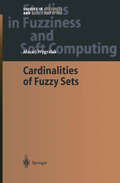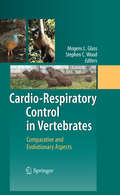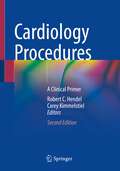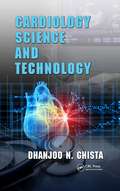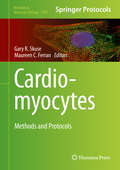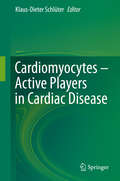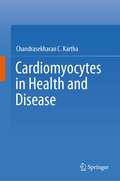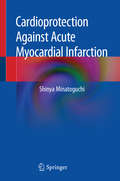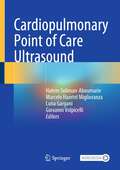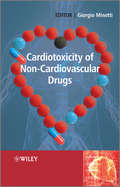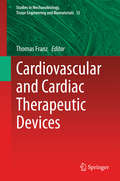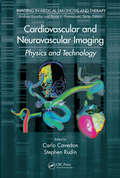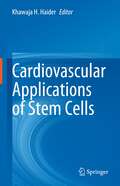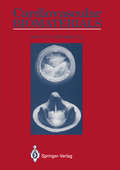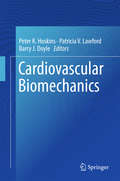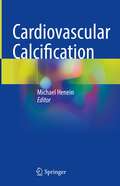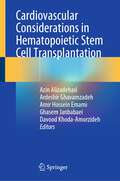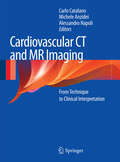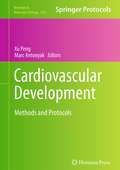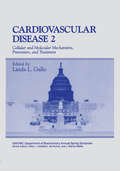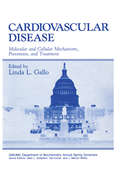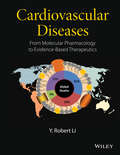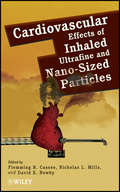- Table View
- List View
Cardinalities of Fuzzy Sets (Studies in Fuzziness and Soft Computing #118)
by Maciej WygralakCounting is one of the basic elementary mathematical activities. It comes with two complementary aspects: to determine the number of elements of a set - and to create an ordering between the objects of counting just by counting them over. For finite sets of objects these two aspects are realized by the same type of num bers: the natural numbers. That these complementary aspects of the counting pro cess may need different kinds of numbers becomes apparent if one extends the process of counting to infinite sets. As general tools to determine numbers of elements the cardinals have been created in set theory, and set theorists have in parallel created the ordinals to count over any set of objects. For both types of numbers it is not only counting they are used for, it is also the strongly related process of calculation - especially addition and, derived from it, multiplication and even exponentiation - which is based upon these numbers. For fuzzy sets the idea of counting, in both aspects, looses its naive foundation: because it is to a large extent founded upon of the idea that there is a clear distinc tion between those objects which have to be counted - and those ones which have to be neglected for the particular counting process.
Cardio-Respiratory Control in Vertebrates: Comparative and Evolutionary Aspects
by Mogens L. Glass Stephen C. WoodHopefully, this book will be taken off of the shelf frequently to be studied carefully over many years. More than 40 researchers were involved in this project, which examines respiration, circulation, and metabolism from ?sh to the land vertebrates, including human beings. A breathable and stable atmosphere ?rst appeared about 500 million years ago. Oxygen levels are not stable in aquatic environments and exclusively water-breathing ?sh must still cope with the ever-changing levels of O 2 and with large temperature changes. This is re?ected in their sophisticated count- current systems, with high O extraction and internal and external O receptors. 2 2 The conquest for the terrestrial environment took place in the late Devonian period (355–359 million years ago), and recent discoveries portray the gradual transitional evolution of land vertebrates. The oxygen-rich and relatively stable atmospheric conditionsimpliedthatoxygen-sensingmechanismswererelativelysimpleandl- gain compared with acid–base regulation. Recently, physiology has expanded into related ?elds such as biochemistry, molecular biology, morphology and anatomy. In the light of the work in these ?elds, the introduction of DNA-based cladograms, which can be used to evaluate the likelihood of land vertebrates and lung?sh as a sister group, could explain why their cardio-respiratory control systems are similar. The diffusing capacity of a duck lung is 40 times higher than that of a toad or lung?sh. Certainly, some animals have evolved to rich high-performance levels.
Cardiology Procedures: A Clinical Primer
by Robert C. Hendel Carey KimmelstielThis extensively revised edition is a single compact reference that describes a wide variety of diagnostic and therapeutic procedures performed by cardiologists. The focus is on the clinical application of these procedures with descriptions of their technical aspects, as well as contraindications and potential complications. The book provides detailed instruction on the interpretation of clinical data generated during these procedures and includes case presentations to illustrate how they are utilized in clinical practice.Cardiology Procedures: A Clinical Primer contains distilled clinical information and data important to those involved in the clinical care of cardiac patients. Comprising practical material designed to help in learning the diagnostic and therapeutic cardiology procedures performed in clinical practice, it will also be useful for trainees and practitioners in related disciplines.
Cardiology Science and Technology
by Dhanjoo N. GhistaCardiology Science and Technology comprehensively deals with the science and biomedical engineering formulations of cardiology. As a textbook, it addresses the teaching, research, and clinical aspects of cardiovascular medical engineering and computational cardiology. The books consists of two sections. The first section deals with left ventricular
Cardiomyocytes: Methods and Protocols (Methods in Molecular Biology #1299)
by Gary R. Skuse and Maureen C. FerranThis volume has been assembled for scientists interested in basic and applied biomedical research directed toward understanding the development, genetics and function of cardiomyocytes. The methods and protocols contained within it address cell culture techniques, cardiomyocyte differentiation and redifferentiation, experimental induction of cardiomyopathies, introducing genes into cardiomyocytes, genomic approaches to the understanding cardiomyocytes, cryopreservation of neonatal cardiomyocytes and modeling of cardiomyocyte function. Written in the highly successful Methods in Molecular Biology series format, chapters include introductions to their respective topics, lists of the necessary materials and reagents, step-by-step, readily reproducible laboratory protocols and tips on troubleshooting and avoiding known pitfalls. Practical and current, Cardiomyocytes: Methods and Protocols explores complimentary areas of cardiomyocyte science that, taken together, can inform individuals with a broad range of interests.
Cardiomyocytes – Active Players in Cardiac Disease
by Klaus-Dieter SchlüterThis book summarizes our current understanding about the biology and patho-biology of cardiomyocytes and depicts common techniques for the study of these cells. The book is divided into two parts; the first part provides insight into role and function of cardiomyocytes under normal conditions and describes embryogenesis and differentiation, in the second part the role of cardiomyocytes in aging and disease is discussed and cellular responses under stress conditions illustrated. Cardiomyocytes represent the main mass of the heart, and cellular malfunction directly modifies heart function leading to subsequent heart failure. As such, cardiomyocytes are causative involved in the main reasons of heart failure, such as post-infarct remodeling, hypertensive heart disease, idiopathic heart failure, and interactions with other co-morbidities such as diabetes. On the other hand, cardiomyocytes are necessarily target of therapy. Therefore, a precise understanding of cardiomyocytes biology is a pre-requisite for proper disease treatment and evidence based medicine. The book is written for cell biologists, pharmacologists and biomedical researchers specialized in cardiac and vascular biology.
Cardiomyocytes in Health and Disease
by Chandrasekharan C. KarthaThis book is a treatise on cardiomyocytes, the most important cell for the contractile function of the heart. There has been significant progress in our understanding of the function-related structure, developmental processes and their determinants, mechanisms of cell cycle regulation, post-natal growth, energy metabolism, and reversible and irreversible response of cardiomyocytes to diverse forms of physiological stress and injury. There is also more clarity on the alterations in the biological mechanisms in cardiomyocytes that lead to pathological states and the changes in the cells that occur secondary to disease conditions. Thanks to these advances in knowledge, there have been great gains in attempts to identify disease biomarkers and therapeutic targets for better management of patients with heart diseases. Possibilities to induce regeneration or proliferation of cardiomyocytes and thus repair and or regenerate the damaged heart are also on the horizon.
Cardioprotection Against Acute Myocardial Infarction
by Shinya MinatoguchiThis book will provide readers with a detailed understanding of the ischemic damage to the myocardium after myocardial infarction, as well as essential tools for the treatment of damaged heart after myocardial infarction. It discusses various methods such as pharmacological pre- and post-conditioning, cytokine therapy, and cell therapy especially using Muse cells.The coverage of Muse cell therapy, which includes the latest work done by the author and his collaborators, is a unique feature of the book. Muse cells have self-renewability and have ability to differentiate into cells with the characteristics of all three germ layers from a single cell, while they are non-tumorigenic. It is the first book to feature the Muse cell therapy, which may offer the new promising therapeutic strategy for acute myocardial infarction.
Cardiopulmonary Point of Care Ultrasound
by Hatem Soliman-Aboumarie Marcelo Haertel Miglioranza Luna Gargani Giovanni VolpicelliThis book is an illustration-rich practically focused resource on the use of cardiopulmonary point of care ultrasound (POCUS). It focuses on the applications of POCUS in a wide range of medical specialties especially critical care medicine, cardiology, emergency and respiratory medicine. Topics covered include the application of POCUS in diagnostics, monitoring of various cardiorespiratory conditions such as pulmonary edema, and the role it can perform in guiding interventions for pleural and pericardial effusion. Stunning illustrations and instructive accompanying video clips ensure that the reader can develop a deep understanding of how to properly apply the technology into day-to-day clinical practice. Cardiopulmonary Point of Care Ultrasound is edited and authored by a group of world-renowned experts in the field of critical care echocardiography and POCUS from critical care medicine, cardiology, respiratory medicine, emergency medicine, surgery, radiology and cardiac physiology with a powerful multi-specialty and multi-disciplinary collaboration. It offers detailed insight into the applications of this technique and associated technologies across medical specialties with a focus on cardiorespiratory disorders. The user-focused emphasis in this resource makes it an ideal bedside manual for both experienced practitioners and trainees in these fields.
Cardiotoxicity of Non-Cardiovascular Drugs
by Giorgio MinottiSome drugs which are not aimed at treating heart disease have nevertheless been found to have profound effects on heart muscle. Cardiotoxicity is one of the major forms of toxicity seen in drugs and it accounts for most drug recalls and delays experienced in regulatory approvals.In recent years a number of non-cardiac blockbuster drugs such as terfenadine have been withdrawn from major markets because of cardiotoxicity concerns, while other drugs have either been withdrawn prior to marketing or required labelling changes that significantly restricted their use. In Cardiotoxicity of Non-Cardiovascular Drugs international experts describe the molecular mechanisms and clinical read-outs of cardiac events induced by a broad variety of noncardiovascular drugs. Particular emphasis is paid to the preclinical screening of drug cardiotoxicity. Topics include: metabolic targets of cardiotoxicity regulatory aspects translating molecular mechanisms into clinical trials structure-activity relationships in arrhythmias by antihistamines and psychoactive drugs cardiovascular toxicity of antitumor drugs cardiovascular toxicities of non-steroidal anti-inflammatory drugs cardiovascular toxicities of antiretroviral therapies Cardiotoxicity of Non-Cardiovascular Drugs is an essential guide to this important area of drug development. It will find a place on the bookshelves of researchers, regulators and students in medicinal chemistry, drug development, pharmacology, pharmacy and cardiovascular disease.
Cardiovascular and Cardiac Therapeutic Devices (Studies in Mechanobiology, Tissue Engineering and Biomaterials #15)
by Thomas FranzThis volume focuses on latest research in therapeutic devices for cardiovascular, i.e. vascular and valvular and cardiac diseases. In the area of vascular therapies, aspects covered relate to latest research in small-diameter tissue-regenerative vascular grafts, one of the greatest persisting challenges in cardiovascular therapies, stent grafts and endovascular stents for percutaneous arterial interventions. Contributions on valvular therapies focus on tissue engineered and tissue regenerative prosthetic heart valves and valvular prostheses for trans-apical implantation including the challenges posed on the prosthesis design. The section on cardiac diseases aims at covering therapeutic advances for myocardial infarction and prevention of heart failure and on in vivo biomechanics of implantable cardiac pacemaker devices. A further section complements these three areas by presenting constitutive modelling of soft biological tissues of the cardiovascular system, an area imperative for advanced numerical and computational modelling in the development and optimisation of cardiovascular devices and therapies.
Cardiovascular and Neurovascular Imaging: Physics and Technology
by Carlo Cavedon Stephen RudinCardiovascular and Neurovascular Imaging: Physics and Technology explains the underlying physical and technical principles behind a range of cardiovascular and neurovascular imaging modalities, including radiography, nuclear medicine, ultrasound, and magnetic resonance imaging (MRI). Examining this interdisciplinary branch of medical imaging from a
Cardiovascular Applications of Stem Cells
by Khawaja H. HaiderThe book covers multifarious aspects of stem cell-based therapy for cardiovascular diseases. In addition to stem cells from different sources for cell-based therapy, it covers stem cell organoids and stem cell-derived exosomes in regenerative medicine. The book also encompasses advances in state-of-the-art infrastructure to improve the maturation aspects of pluripotent stem cells-derived cardiomyocytes using a novel scaffold-based cell culture system for cell delivery in experimental animal models and clinical settings. Besides the use of mesenchymal stem cells, the book includes chapters on the use of cardiac progenitor cells (CPCs), microtissue implantation, use of PSCs for valvulopathies, application of de-cellularized organ arrays as natural scaffolds for cardiac tissue engineering, use of epicardial stem cells, and skeletal myoblasts in cell-based therapy for myocardial regeneration. Besides the cell-based therapy approach, the book also reviews the stem cell-derived exosomes, their characteristics, and engineering strategies to enhance their therapeutic potential via targeting and drug loading and use in disease models. Additionally, the book also discusses the latest research on injectable hydrogels for cardiovascular regeneration and how hydrogel-based delivery protects the cells and their retention post-engraftment in the heart, a problem, which significantly reduces the efficacy of cell-based therapy.
Cardiovascular Biomaterials
by Garth W. HastingsCardiovascular Biomaterials presents current research material developed by contributors from universities and professional laboratories in the UK, USA, Canada, and Germany.
Cardiovascular Biomechanics
by Peter R. Hoskins Patricia V. Lawford Barry J. DoyleThis book provides a balanced presentation of the fundamental principles of cardiovascular biomechanics research, as well as its valuable clinical applications. Pursuing an integrated approach at the interface of the life sciences, physics and engineering, it also includes extensive images to explain the concepts discussed.With a focus on explaining the underlying principles, this book examines the physiology and mechanics of circulation, mechanobiology and the biomechanics of different components of the cardiovascular system, in-vivo techniques, in-vitro techniques, and the medical applications of this research.Written for undergraduate and postgraduate students and including sample problems at the end of each chapter, this interdisciplinary text provides an essential introduction to the topic. It is also an ideal reference text for researchers and clinical practitioners, and will benefit a wide range of students and researchers including engineers, physicists, biologists and clinicians who are interested in the area of cardiovascular biomechanics.
Cardiovascular Calcification
by Michael HeneinThe book systematically describes the clinical and scientific aspects of cardiovascular calcification. Chapters detail the mechanisms associated with arterial and valve calcification, relevant risk factors, pathophysiology and the latest therapeutic techniques. Recent diagnostic technological developments including how computed tomography (CT) scanning can be utilized along with Agatston score to quantify coronary arterial calcification when investigating whether a patient for sub-clinical atherosclerosis are covered. The correlation with the presence of arterial calcification and extent of coronary stenosis is also explored. Cardiovasular Calcification details relevant aspects of the basic science and reviews the latest pathological and therapeutic techniques used in treating patients with cardiovascular calcification. It is therefore an essential resource for practicing cardiologists, cardiac surgeons, vascular specialists and radiologists.
Cardiovascular Considerations in Hematopoietic Stem Cell Transplantation
by Azin Alizadehasl Ardeshir Ghavamzadeh Amir Hossein Emami Ghasem Janbabaei Davood Khoda-AmorzidehThis book discusses the epidemiology and the known cardiotoxic effects of chemoradiation agents in addition to newer therapies in hematopoietic stem cell transplantation (HSCT). Recent expert consensus statements from cardiology and hematology/oncology societies are reviewed in regard to risk stratification of the patient based on the type of treatments they are undergoing. Finally, gaps in knowledge are identified with proposed avenues of research that allow for more accurate risk assessment, prediction and potential treatment of the HSCT patient in attenuating the risk of developing cardiovascular comorbidities.Cardiovascular Considerations in Hematopoietic Stem Cell Transplantation reveals a picture of effective management of these patients in order to optimize both short- and long-term outcomes of HSCT. It is of considerable interest to all involved or training within this rapidly growing area of cardiology and oncology.
Cardiovascular CT and MR Imaging: From Technique to Clinical Interpretation
by Carlo Catalano, Michele Anzidei and Alessandro NapoliThe availability and diffusion of high-performance technologies has strengthened the role of CT angiography and MR angiography as simple and reliable techniques for the characterization and treatment planning of the main diseases of the cardiocirculatory system, an understanding of which has become essential for all radiologists. The aim of this book is to provide technical indications which are both concise and thorough regarding the main methods and examination techniques for performing high-quality CT angiography and MR angiography studies in a broad range of clinical settings. This is supported by a large number of cases and is rich with advice on image interpretation and practical suggestions for the evaluation and reporting of the examinations. The text will therefore also aim to provide a comparison of the advantages and limitations of the two techniques in various diseases and vascular regions, thus offering indications to both the expert and trainee radiologist.
Cardiovascular Development: Methods and Protocols (Methods in Molecular Biology #843)
by Xu Peng and Marc AntonyaksCongenital heart disease is the leading cause of infant death and affects approximately one in every 100 babies born in the United States. The study of cardiovascular development has acquired new momentum in last twenty years due to the advancement of modern molecular biology and new available equipments and techniques. In Cardiovascular Development: Methods and Protocols expert researchers in the field in the field detail many of the methods which are now commonly used in the field of cardiovascular development research. These include methods and technique for using different organisms for cardiovascular developmental research, using cell and molecular biology methods to study cardiovascular development, as well as other available techniques for cardiovascular development research. Written in the highly successful Methods in Molecular Biology™ series format, chapters include introductions to their respective topics, lists of the necessary materials and reagents, step-by-step, readily reproducible laboratory protocols, and key tips on troubleshooting and avoiding known pitfalls.Authoritative and practical, Cardiovascular Development: Methods and Protocols seeks to aid scientists in understanding new state-of-the-art techniques in the field of cardiovascular development research including in vivo imaging and Bioinformatics.
Cardiovascular Disease: Cellular and Molecular Mechanisms, Prevention, and Treatment (Gwumc Department of Biochemistry and Molecular Biology Annual Spring Symposia)
by Linda L. GalloThe Fourteenth Washington International Spring Symposium, held in Washington, D.C., in June 1994, brought together over 400 leading scientists from 21 countries to review and update research on cardiovascular disease. This group satisfied the symposium goals of formulating a more comprehensive and integrated picture of the events contributing to atherosclerosis and of exploring modified gene expression as an to understanding the causes of atherosclerosis and providing clues to the approach prevention and treatment. This volume contains most of the papers presented at the eight plenary sessions together with selected contributions from the special sessions. The multidisciplinary nature of the chapters and their authors should stimulate the interests of biochemists, cell and molecular biologists, pathologists, pharmacologists, epidemiologists, nutritionists, and clinicians. The volume is divided into eight sections which reflect the focus of the plenary sessions. Part I focuses on the pathophysiology of atherosclerotic plaques and predicts that the nature of the fibrous cap of atheroma determines plaque disruption and clinical events. Papers in Part II deal with atherogenic lipoproteins. The introductory paper reviews the current view of the role of plasma lipoproteins in atherosclerosis. With respect to the newer members on the list,: [oxidized LDL, Lp(a)] evidence is provided that suggests the involvement of one major gene in the development of oxidized LDL lipids. the expression of inflammatory genes, and the development of aortic fatty streaks.
Cardiovascular Disease: Molecular and Cellular Mechanisms, Prevention, and Treatment (Gwumc Department of Biochemistry and Molecular Biology Annual Spring Symposia)
by Linda L. GalloThe Sixth Annual International Spring Symposium on Health Sciences, held in Washington, D. C. , in May 1986, brought together over 650 scientists from 19 countries to review and update research on cardiovascular disease. In this volume, which contains 59 chapters, an internationally recognized group of authors con tribute up-to-date accounts of molecular and cellular processes occurring in the vessel wall in atherogenesis and describe approaches to the prevention and treatment of atherosclerosis. The volume is divided into six major sections. Two sections deal with current aspects of lipoprotein metabolism. In Part I, we are alerted to the impact on li poprotein metabolism of structural heterogeneity within the four broad lipoprotein classes. Attention then turns to the components that orchestrate lipoprotein metab olism. Apolipoprotein identities, processing, and functions are described, as are the roles of lipid transfer proteins in plasma lipoprotein remodeling. Hepatic lipase synthesis and secretion are described. In Part II, Nobel Laureates Michael S. Brown and Joseph L. Goldstein describe mutations in the LDL receptor that reveal the functions of its various domains and point out how understanding the LDL receptor has provided a rational basis for its regulation. A discussion of the role of receptors in regulating cholesterol uptake by tissues follows, with emphasis on receptor-ligand interactions. Additional pathways for cholesterol delivery to cells are explored, as are pathways for cholesterol egress.
Cardiovascular Diseases: From Molecular Pharmacology to Evidence-Based Therapeutics
by Y. Robert LiWritten in an accessible style and consistent format, the book covers both the fundamentals and advances in the pharmacology of cardiovascular drugs, as well as their integrated applications in the management of individual cardiovascular diseases. • Integrates fundamentals and recent advances regarding cardiovascular drugs, blending basic and clinical sciences needed to effectively understand and treat cardiovascular diseases • Facilitates understanding of drug action and mechanism by covering physiology / pathophysiology and pharmacology • Includes guidelines and algorithms for pharmacotherapeutic management of cardiovascular diseases • Uses case presentations and study questions to enhance understanding of the material • Serves as a resource for pharmaceutical and medical students and researchers interested in cardiovascular issues
Cardiovascular Diseases: From Molecular Pharmacology to Evidence-Based Therapeutics
by Y. Robert LiWritten in an accessible style and consistent format, the book covers both the fundamentals and advances in the pharmacology of cardiovascular drugs, as well as their integrated applications in the management of individual cardiovascular diseases. • Integrates fundamentals and recent advances regarding cardiovascular drugs, blending basic and clinical sciences needed to effectively understand and treat cardiovascular diseases • Facilitates understanding of drug action and mechanism by covering physiology / pathophysiology and pharmacology • Includes guidelines and algorithms for pharmacotherapeutic management of cardiovascular diseases • Uses case presentations and study questions to enhance understanding of the material • Serves as a resource for pharmaceutical and medical students and researchers interested in cardiovascular issues
Cardiovascular Effects of Inhaled Ultrafine and Nano-Sized Particles
by Flemming R. Cassee Nicholas L. Mills David E. NewbyThis book assists scientists, toxicologists, clinicians, and public health regulators to understand the complex issues that determine the impact of air pollution on the cardiovascular system. It covers a range of relevant topics including particulate matter (PM) sources and characterization, methods of exposure, impact of PM on cells and systems, role of particles in the pathophysiology of cardiovascular disease, risk assessment, and potential environmental and therapeutic interventions.
Cardiovascular Effects of Inhaled Ultrafine and Nano-Sized Particles
by Flemming R. Cassee Nicholas L. Mills David E. NewbyThis book assists scientists, toxicologists, clinicians, and public health regulators to understand the complex issues that determine the impact of air pollution on the cardiovascular system. It covers a range of relevant topics including particulate matter (PM) sources and characterization, methods of exposure, impact of PM on cells and systems, role of particles in the pathophysiology of cardiovascular disease, risk assessment, and potential environmental and therapeutic interventions.
